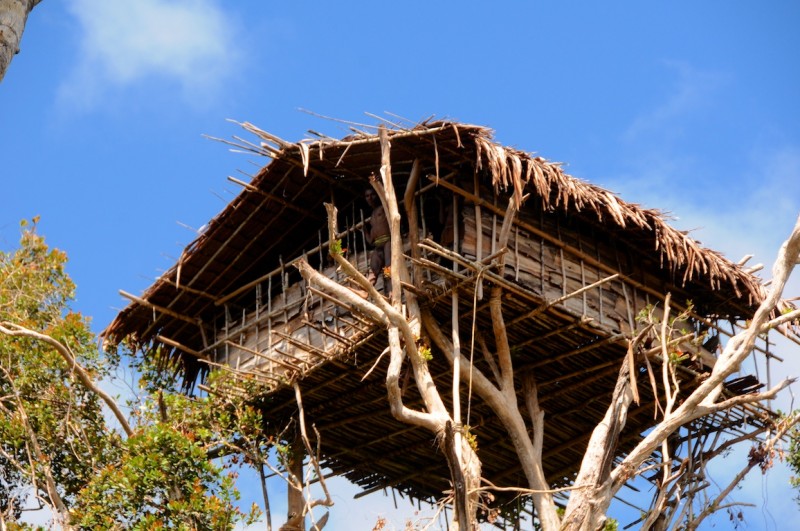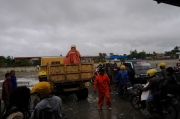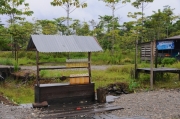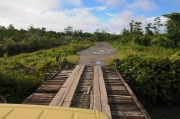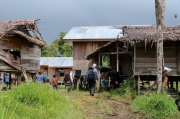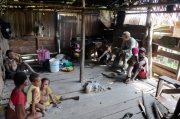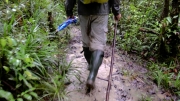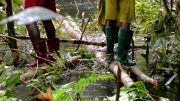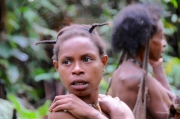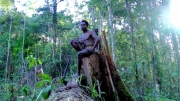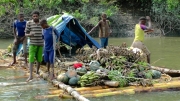[no_toc]
This is the second part of the travelogue with the expedition to the Kuruwai, the forest nomads in the rainforest. Here you can find the first part around Sentani and the highlands of Wamena with the Dani tribe. On YouTube, there are also several video clips about the expedition.
The way to the Kuruwai
Slowly it gets serious. Only a very small part of Papua visitors take the arduous journey and travel to the undeveloped areas. Most visitors hang around Wamena or Jayapura. Now there are undeveloped areas, day long rides on the dugout, impenetrable jungle, miles of walking, spiders, snakes and other animals and, our expedition destination, Stone Age people waiting for us. Now we fly on the plane to Dekai south to the lowlands.That’s why it was necessary to reduce the baggage, anything unnecessary went to Jayapura by freight to the hotel where we spent the last night in West Papua. We arrived in Dekai several hours later than planned, which confused the intended procedure.
First it went to the „center“ of Dekai, the last opportunity for purchases. About two to three dozen shops in wooden shacks and alleys in between, a covered market, that’s all. In the first place bought tons of tobacco, as a gift for the Kuruwai and the porter and all the smoke. So everyone we have to deal with. Smoking is the favorite pastime of almost all Papuans, whether man, woman or child. Also on the shopping list: umbrellas. Sounds a bit strange, but practical for the open boat
On the Rivers Brazza and Siret
The next morning we went on the bed of a gravel truck to the port of Dekai. A few wooden huts (shops), a few smaller boats, no wharf or similar. Our boat, a canopy with outboard engine, which provided space for two people side by side, was around 15m long, was hewn from a single giant of the jungle. So loaded the dugout and off we went. We then went by boat for eight / nine hours, with a few stops in small settlements in between, until we reach a suitable mission space for the overnight stay – now only in the tent. Settlement, also on the river, is barely down here. Featured is an endless green jungle landscape where the boat snaked along, occasionally interrupted by a small village or individual huts.
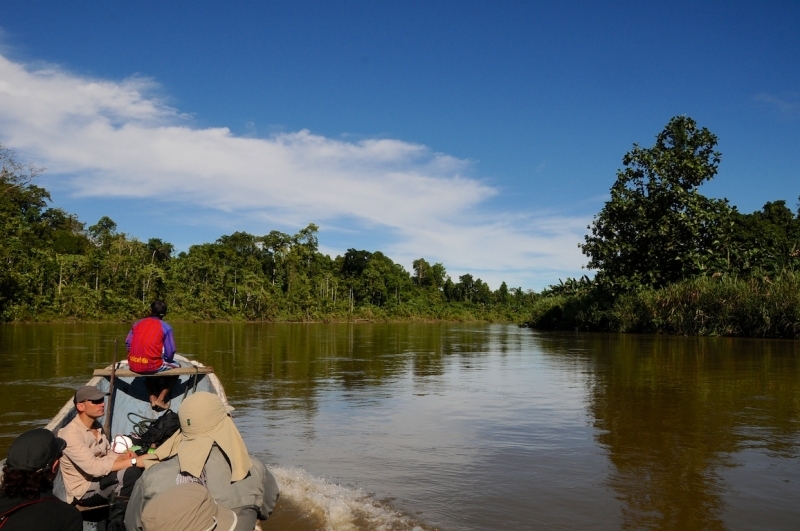
The next morning we went on very early. Although at first the dismantling of the tents was unthinkable, too wet. Positive, the rain is warm, you get used to it quickly. With the onward journey it took a bit longer, the time lost in the last days could not be recovered. Shortly after 1pm we reach our destination of the day, Mabul, situated on the upper reaches of the Siret. It is a village of perhaps 50 inhabitants that was built by the government on the river. For us the starting point for the tour to the forest nomads.
The next day we started with 15 carriers, from here it was only on foot. When strangers arrive, villagers from all corners drag their artefacts and utensils around to make a small business (which they do). They brough whistles, chains of dog and pig teeth, bows and arrows for example for bird, fish hunting or even those that were (formerly) used in combat, nets, shields (for defense), bone knives, straw sticks, jewelry utensils, sago lambs and many more. Actually, all her household goods. They offer it for cash or tobacco. Especially interesting are the big shields. The motives vary from clan to clan. Here in Mabul the shields are decorated with flowers of lianas, stars, the moon and always the navel, the human with a piece of umbilical cord. Making such a shield is not easy, it can take up to a month. But time is not an issue here.
A topic of conversation not only in Mabul was cannibalism. It did happen in these regions not so long ago? Where was … Basically for the Kuruwai in a death always witchcraft is in the game, a natural death did not seem to know. So you have to find the sorcerer. Even though diseases and the associated high infant mortality rates are the main cause of the low life expectancy of perhaps 30 to 35 years. You can get sick very quickly here. For example, Elephantiasis is widespread. Outer sign: monstrous feet, the cause of lymphoma due to infection.
March through the Rain Forest
The next day it started really. Our expedition leader, after consultation with the villagers, decided to visit a clan about five kilometers away. Not much, actually, we thought. It is raining again, the climate is not easy to endure for us Europeans. No breeze, more than 35 ° C and over 95% humidity. Our group consisted of eight travelers, the expedition leader, his son, a cook and a „girl for everything“ and 15 porters from the village. Everything has to be taken along: tents, cooking equipment, food (except for what the jungle offers such as sago, plantains, leafy vegetables, insects), photographic and film accessories and of course the personal expedition equipment. Even in an emergency, there is no help, you depend on yourself and the knowledge of the expedition leader and the locals.
Our porters are very modest about their own luggage. Some have something with them, small handy bundles. Others do not. Food, nil. Some women of the porters also came with us, one carrying their baby, another a young piglet (not to eat), both in the typical net worn on the forehead and hanging from the back.
Before we came to the first Kuruwai, who were still living originally, the five kilometers of the jungle march started. Sounds little, is a lot and demands everything from one. It took six hours for these five kilometers. So just an average of 800 m per hour. There are no paths in our sense, it goes through water, mud or over and on top of fallen tree trunks through the jungle. Next to a hiking stick very important: Good rubber boots. Keep your feet dry and water and mud outside. I thought at the beginning. Was a mistake. Once the rubber boots have run full, you quickly get used to it. Although their weight including mud and water is quite high. In the way also numerous streams and 10 to 15 m broad rivers. Here the ax was used. To cut larger trees than transition, a kind of tree bridge. Not easy.
Nevertheless, we managed to reach the first Kuruwai settlement called Murup, the name of the boss. At the moment two houses are inhabited here, with five adults. The women are in the woods, including Murup, who decides ifand how long we can stay here. The first signals (of men) are positive. On the contrary, we seem to be able to stay here even two nights, the Kuruwai want to give us one of the sago palms, for a demonstration of the Sago harvest. It then came so after Murup arrived, we could stay two days. Is also a rare change for the Kuruwai.
Picture gallery of the drive to Mabul and the walk through the rainforest
The Kuruwai
The forest nomads live perfectly adapted to the nature in these largest contiguous primeval forests of our earth. Even her 30, sometimes 40-meter high tree houses show how they have adjusted to the life-threatening environment. Only relatively few visitors penetrate to the villages and settlement areas of the Kuruwai, have visited or seen them. Now we belong to it. First contact attempts took place in 1978, just over 30 years ago.
For the long non-development of the area essentially plays a role that there are no natural resources. So they were left largely alone, with the exception of the Christian missionaries. Although some parts of the settlement area are still unexplored, there are still some undiscovered clans that have no contact with strangers. All in all, around 5,000 people are expected to live in the area of about 300 to 400 square kilometers.
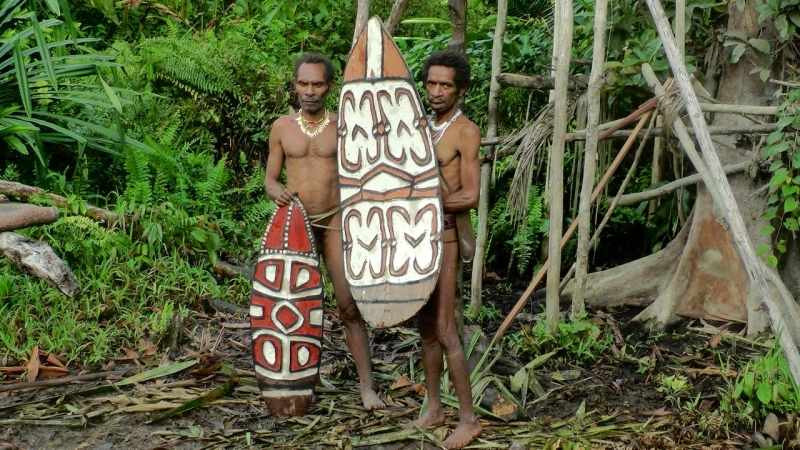
You can visit the Kuruwai since the early 1990s reasonably safe. Even the initial name of the forest nomads for us whites says a lot: Laleo. That means in their parlance as much as demons. It comes from the fact that we are of the same color as the deceased. Incidentally, they are either completely burned or simply left in the tree house and the settlement is abandoned.
Most Kuruwai, like thousands of years ago, are similar to the Stone Age people. Although the families we visited already used a metal hatchet instead of the stone ax, that was it. Incidentally, they received them via the carriers during the rare visits. So most Kuruwai know to this day neither iron nor other metals. Unknown are also the writing or pottery.
A family usually includes up to eight people. It is gender separation, the group is too big, she shares. The Kuruwai men are not dressed. The Koteka, the penis quiver of Dani and Asmat are not known here. The women wear a skirt made of sago fibers. No Kuruwai woman leaves the tree house without a harness, no man without a bow and arrow. He needs it for the hunt. The main food is sago, pure carbohydrates, and the insects and sagolar veins are responsible for proteins.
Picture gallery of the Kuruwai
Sago palms need marshy soil. To obtain the sago, a mature sago palm is felled and debarked. To obtain the sago, a mature sago palm is felled and debarked.The big shafts of the palm leaves are needed for the washing device. The lower part of the trunk is knocked small and fibrous by means of stick-like wooden implements, a heath work lasting several hours. Parallel to this, two older women are building the washing device. The fibers come up into a gutter with a cloth between them as a filter. The women now knead the shavings with water until the starch comes out. The milky water flows slowly through the fabric filter and collects in a depression in the next channel, here the sago settles. What remains is the pure, almost white mass. Tastes like nothing, pure strength. Subsequently, the Kuruwai still collect insects and grubs. Proteins must be.
Life in 35 m height – Treehouse extremely
The next morning we said goodbye to the so hospitable Kuruwai and we went about two hours through the jungle to another family. Our destination was the Dusum Lobol (named again after a family member). The head of the family has built here a typical men’s house, so around 35 m high. This seems to impress the women here, after all, accompanied him already two younger ladies, one with baby. He built it with two friends in three months. He was so proud of it, it was clear to him, so he was posing for photography and filming.
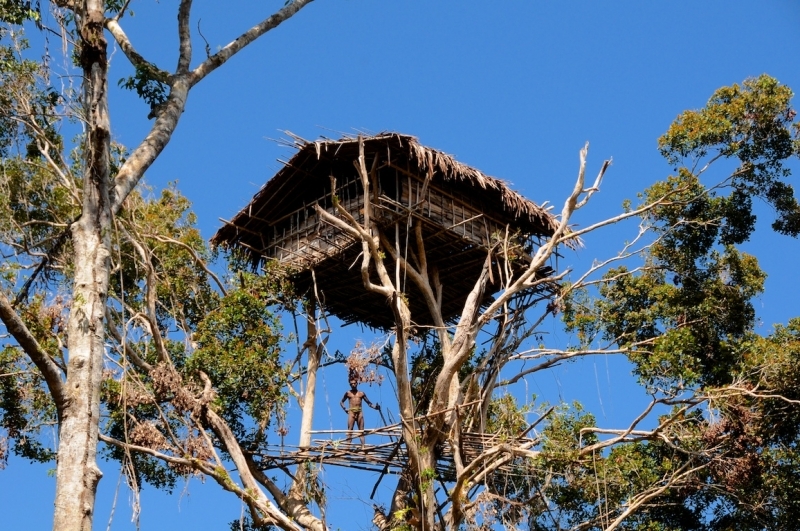
The treehouse. Really impressive. In any case, a crazy job and an incredible construction. Of course not designed for the weight of a European like me, only for a Kuruwai. Everything, really everything about the tree houses are natural products (wood, palm leaves and lianas), no nail, nothing. The floor consists of wooden poles that are covered with bark. Such a tree house will last about three to five years, then a new one will be built. Weather and insects attack the wood strongly. Originally a treehouse sheltered from attacks by enemy clans, diseases and floods. Approaching enemies could be seen more easily in the cleared clearing. Well, then the tree house was simply lit, but from above it was easy to hit the enemy with arrows.
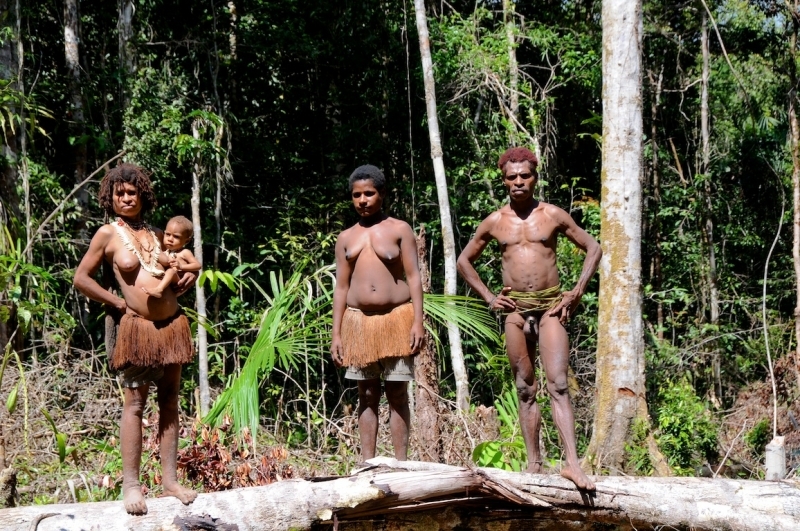 The next day it was only a short walk of about an hour, to the banks of the Siret, where we should be picked up from the boat. Should, because the low water level did not allow the boat to come up to us. So we had to spend two or three hours in the jungle the next day to get to the boat for the two-day return to Dekai.
The next day it was only a short walk of about an hour, to the banks of the Siret, where we should be picked up from the boat. Should, because the low water level did not allow the boat to come up to us. So we had to spend two or three hours in the jungle the next day to get to the boat for the two-day return to Dekai.
We use the day to write a diary, rest, leave, and show a kuruwai how to make the shields from the root of the board, and look at their artefacts (and take one or the other back with them). We started early (around 6.30) to get to Mabul, our starting point and to our boat. The two-day return trip then interrupted because of low water and we stop at various tribes, including the Brazza on the same Brazza River in Patipi -Iwawa, where we wanted to stay overnight on arrival. So we could keep our formerly given promise and at least stop for a rest. As usual, the villagers brought in parts of their household goods, weapons and signs to do some business. Two hours later, we reached the port of Dekai, and the next day, after eight hours of waiting time, we went to Jayapura with a propeller plane before embarking on the return journey with a three-day stopover in Bali.
Picture gallery on the way back to civilization
Summary
An unusual tour, the Dani and the rarely visited Kuruwai. Definitely the highlights of this trip and all, really worth the effort. The Dani are relatively easy to reach. Those who shy away from the exertions of a jungle tour, here he comes at his expense. Especially since around Wamena in the Baliem Valley much more visit and visit, as we were possible in the three days. The highlight, of course, was the tour to the Kuruwai. They were friendly to us, pure hospitality. Are we just as interesting for them as they are for us? Also, I have never and nowhere even felt threatened at all, as the tour is actually to do for all who are open to foreign cultures. You have to be tolerant, be able to cope with simple conditions and be reasonably fit.
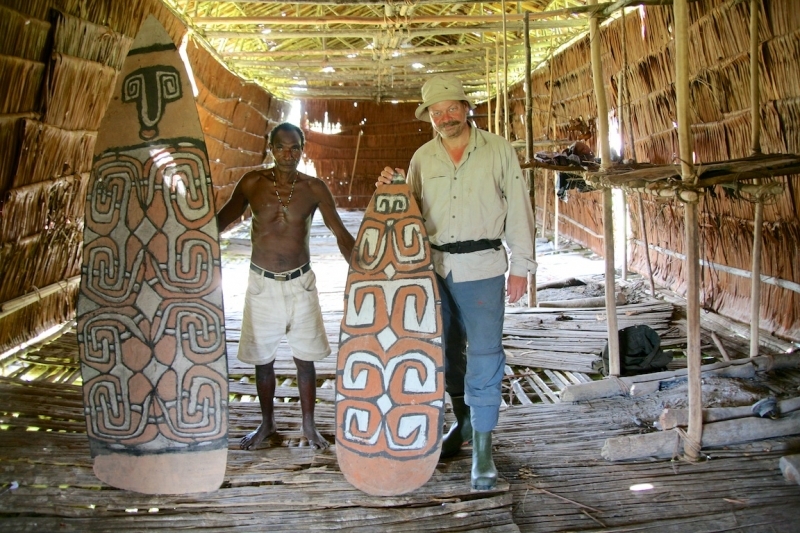
Sources: Wikipedia, own experiences, Werner Götz, Winnenden, Germany, June / July 2012
Here you can find the first part around Sentani and the highlands of Wamena with the Dani tribe.
